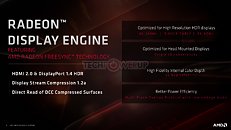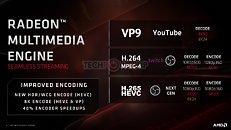Wednesday, June 12th 2019

AMD Navi Radeon Display Engine and Multimedia Engine Detailed
Two of the often overlooked components of a new graphics architecture are the I/O and multimedia capabilities. With its Radeon RX 5700-series "Navi 10" graphics processor, AMD gave the two their first major update in over two years, with the new Radeon Display Engine, and Radeon Multimedia Engine. The Display Engine is a hardware component that handles the graphics card's physical display I/O. The Radeon Multimedia Engine is a set of fixed-function hardware that provides CODEC-specific acceleration to offload your CPU.
The Navi Radeon Display Engine features an updated DisplayPort 1.4 HDR implementation that's capable of handling 8K displays at 60 Hz with a single cable. It can also handle 4K UHD at 240 Hz with a single cable. These also include HDR and 10-bit color. It achieves this by implementing DSC 1.2a (Display Stream Compression). The display controller also supports 30 bpp internal color-depth. The HDMI implementation remains HDMI 2.0. The multi-plane overlay protocol (MPO) implementation now supports a low-power mode. This should, in theory, reduce the GPU's power draw when idling or playing back video.The Radeon Multimedia Engine is updated with support for more CODECs. The "Navi 10" GPU provides hardware-acceleration for decoding VP9 video at formats of up to 4K @ 90 fps (frames per second), or 8K @ 24 fps. The H.265 HEVC implementation is more substantial, with hardware-accelerated encoding of 4K at frame-rates of up to 60 fps. H.265 HEVC decoding is accelerated at 8K @ 24 fps, and 4K @ 90 fps, and 1080p at up to 360 fps. H.264 MPEG4 encoding gets a boost of 4K @ 150 fps, and 1080p @ 600 fps decoding; and 4K @ 90 fps and 1080p @ 150 fps encoding.
The Navi Radeon Display Engine features an updated DisplayPort 1.4 HDR implementation that's capable of handling 8K displays at 60 Hz with a single cable. It can also handle 4K UHD at 240 Hz with a single cable. These also include HDR and 10-bit color. It achieves this by implementing DSC 1.2a (Display Stream Compression). The display controller also supports 30 bpp internal color-depth. The HDMI implementation remains HDMI 2.0. The multi-plane overlay protocol (MPO) implementation now supports a low-power mode. This should, in theory, reduce the GPU's power draw when idling or playing back video.The Radeon Multimedia Engine is updated with support for more CODECs. The "Navi 10" GPU provides hardware-acceleration for decoding VP9 video at formats of up to 4K @ 90 fps (frames per second), or 8K @ 24 fps. The H.265 HEVC implementation is more substantial, with hardware-accelerated encoding of 4K at frame-rates of up to 60 fps. H.265 HEVC decoding is accelerated at 8K @ 24 fps, and 4K @ 90 fps, and 1080p at up to 360 fps. H.264 MPEG4 encoding gets a boost of 4K @ 150 fps, and 1080p @ 600 fps decoding; and 4K @ 90 fps and 1080p @ 150 fps encoding.


37 Comments on AMD Navi Radeon Display Engine and Multimedia Engine Detailed
And yet, they fail to implement HDMI 2.1, lol
LG-s this year (OLED) lineup already has HDMI 2.1, so you could use 4K 120Hz, with HDR, and full RGB if you want. And even VRR.
(last years lineup can also do 4K60 or FHD120Hz, but in HDR you cant get full RGB 10-12bit, since the HDMI 2.0 bandwidth is not enough)
The funny thing is, Sony's rated spec of the PS5 means the PS5 will be running HDMI 2.1, so its obvious that AMD already has mostly figured out its implementation however.
So the decision at RTG for the new Navis not to have HDMI 2.1 is not really understandable. Or they have rushed the announcement too much. Either way, it wasnt the right decision.Please explain this? Seems like science fiction to me...
Or they will have an IP block done for the next versions/consoles.
The comment about putting 2.1 features onto 2.1 should be correct; if you can keep the total b/w under the 2.0 spec (18Gbps?), you could in theory add in eARC and other things. e.g. if you were running at 4k/60, SDR there might be room for eARC to send 3D sound. Not ideal, but it could work.
As for HDMI 2.1 features on HDMI 2.0, a few manufacturers have made some features available that are slated for 2.1. ALLM is the one that immediately comes to mind. What nemesis.ie said is pretty well much correct, anything that requires bandwidth won't come until HDMI 2.1, things that don't manufacturers have been adding via firmware (especially Samsung).
AMD is even part of the VirtualLink consortium...
The changes...were...significant.
And as someone wrote here earlier, AMD HAS to adopt the technology too, since the new consoles cant give you the announced 4K 120Hz without that, and they do deliver hardware for them.
So all in all, this was just a rushed release, on a small budget. Like everything in the past years of RTG was.
And you CAN get it, if you buy a DP monitor in due course - which will likely be very expensive (sadly).
It's "only" excluding 8k TVs at the moment and maybe there are a few 4k/120Hz TVs appearing too, both of which are also expensive.
It would be nice, but it's still very "early adopter" which you normally pay a lot extra for it.
Probably these screens will start appearing in mainstream next year and the next Navi/consoles will be ready.
As for what will utilize HDMI 2.1 in the eyes of the HDMI Forum: 8k TV broadcasts, specifically from the upcoming olympics. Remember, TV/AV is a far bigger industry than PC hardware. How many TVs are sold globally in a year? I'd be surprised if gaming PCs capable of driving high refresh rates even at 1080p amounted to 1% of that. TV sports, on the other hand, sells TVs like crazy.
Panasonic had DP on some of their TVs a couple of years back but it seems to be gone now. :(
Why don't we have 8K60 decode support now?